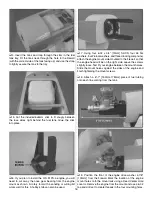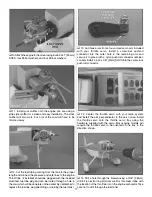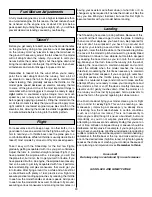
28
Radio Control
1) I will have completed a successful radio equipment ground
check before the fi rst fl ight of a new or repaired model.
2) I will not fl y my model aircraft in the presence of spectators
until I become a qualifi ed fl ier, unless assisted by an
experienced helper.
3) At all fl ying sites a straight or curved line(s) must be
established in front of which all fl ying takes place with the
other side for spectators. Only personnel involved with
fl ying the aircraft are allowed at or in the front of the fl ight
line. Intentional fl ying behind the fl ight line is prohibited.
4) I will operate my model using only radio control frequencies
currently allowed by the Federal Communications
Commission.
5)
I will not knowingly operate my model within three
miles of any pre-existing fl
ying site except in
accordance with the frequency sharing agreement
listed
[in the complete AMA Safety Code].
9) Under no circumstances may a pilot or other person touch
a powered model in fl ight;
nor should any part of the
model other than the landing gear, intentionally touch
the ground, except while landing.
CHECK LIST
During the last few moments of preparation your mind may
be elsewhere anticipating the excitement of the fi rst fl ight.
Because of this, you may be more likely to overlook certain
checks and procedures that should be performed before
the model is fl own. To help avoid this, a check list is provided
to make sure these important areas are not overlooked.
Many are covered in the instruction manual, so where
appropriate, refer to the manual for complete instructions.
Be sure to check the items off as they are completed.
❏
1. Check the C.G. according to the measurements
provided in the manual.
❏
2. Be certain the battery and receiver are securely
mounted in the fuse. Simply stuffi ng them into place
with foam rubber is not suffi cient.
❏
3. Extend your receiver antenna.
❏
4. Balance your model
laterally
as explained in
the instructions.
❏
5. Use threadlocking compound to secure critical
fasteners such as the set screws that hold the wheel
axles to the struts, screws that hold the carburetor arm
(if applicable), screw-lock pushrod connectors, etc.
❏
6. Add a drop of oil to the axles so the wheels will
turn freely.
❏
7. Make sure all hinges are
securely
glued in place.
❏
8. Reinforce holes for wood screws with thin CA where
appropriate (servo mounting screws, cowl mounting
screws, etc.).
❏
9. Confi rm that all controls operate in the correct direction
and the throws are set up according to the manual.
❏
10. Make sure there are silicone retainers on all the
clevises and that all servo arms are secured to the
servos with the screws included with your radio.
❏
11. Secure connections between servo wires and
Y-connectors or servo extensions, and the
connection between your battery pack and the on/off
switch with vinyl tape, heat shrink tubing or special
clips suitable for that purpose.
❏
12. Make sure any servo extension cords you may have
used do not interfere with other systems (servo arms,
pushrods, etc.).
❏
13. Secure the pressure tap (if used) to the muffl er with
high temp RTV silicone, thread locking compound or
J.B. Weld.
❏
14. Make sure the fuel lines are connected and are
not kinked.
❏
15. Balance your propeller (and spare propellers).
❏
16. Tighten the propeller nut and spinner.
❏
17. Place your name, address, AMA number and telephone
number on or inside your model.
❏
18. Cycle your receiver battery pack (if necessary) and
make sure it is fully charged.
❏
19. If you wish to photograph your model, do so before
your fi rst fl ight.
❏
20. Range check your radio when you get to the
fl ying fi eld.
FLYING
The Shoestring .46 ARF is a great-fl ying model that fl ies
smoothly and predictably. The Shoestring does not, however,
possess the self-recovery characteristics of a primary R/C
trainer and should be fl own only by experienced R/C pilots.
CAUTION
(THIS APPLIES TO ALL R/C AIRPLANES):
If, while fl ying, you notice an alarming or unusual sound
such as a low-pitched “buzz,” this may indicate control
surface
fl utter.
Flutter occurs when a control surface (such
as an aileron or elevator) or a fl ying surface (such as a
wing or stab) rapidly vibrates up and down (thus causing
the noise). In extreme cases, if not detected immediately,
fl utter can actually cause the control surface to detach
or the fl ying surface to fail, thus causing loss of control
followed by an impending crash. The best thing to do
when fl utter is detected is to slow the model
immediately
by reducing power, then land as soon as safely possible.
Identify which surface fl uttered (so the problem may
be resolved) by checking all the servo grommets for
deterioration or signs of vibration. Make certain all
pushrod linkages are secure and free of play. If it fl uttered
once, under similar circumstances it will probably fl utter
again unless the problem is fi xed. Some things which
can cause fl utter are; Excessive hinge gap; Not mounting
control horns solidly; Poor fi t of clevis pin in horn; Side-
play of wire pushrods caused by large bends; Excessive
free play in servo gears; Insecure servo mounting; and
one of the most prevalent causes of fl utter; Flying an
over-powered model at excessive speeds.





































